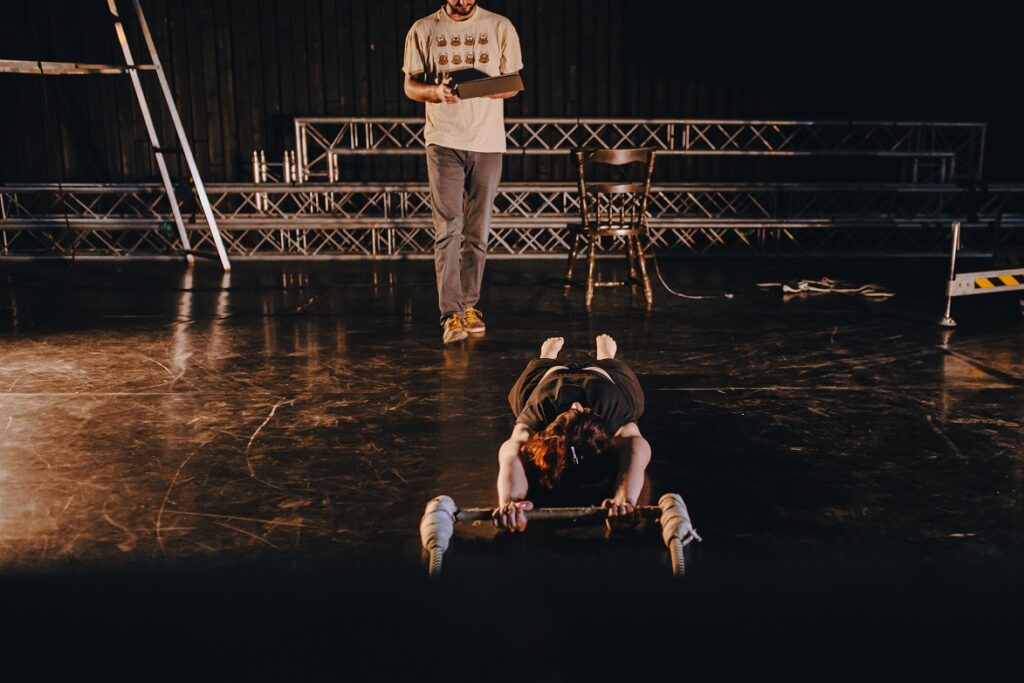French trapeze artist Bambou Monnet and Croatian animation filmmaker Natko Stipanicev worked together in Ghent (Belgium) from 15-28 June 2021. This is their story.
Before our meeting in Gent, we had several Zoom sessions to know each other and to talk about our first ideas. Nikita Maheshwary was our online mentor, she helped us dramaturgically and pushed us to open our minds and go further in the research. First, we talked about the ’emotional journey of the spectator’, a process in a traditional circus show to alternate the emotions felt by the audience during a circus show. Here is a very simple example. A traditional circus show can be composed like this: after the number of the flying trapeze (to feel the fear), there is a number of clowns to relax the audience, and then there is a more poetic number for example. It’s only in the circus that you can feel such a variation of emotions, and we wanted to use that as a working base to see if we could transcribe those emotions specifically in an animated film. The problem with animations is that it takes a lot of time on the computer. With a residency of only 12 days, we immediately know that we can’t use only this tool.
First idea: to put animation techniques in a real circus show
We imagined taking the emotion of the fear. For example, we wanted to make the audience feel that specific emotion, because static trapeze isn’t a very impressive technique and it doesn’t inspire fear. (It is only at 3 meters high, there are no acrobatic tricks but rather movements belonging to the dance vocabulary.) So we thought about making projections around me (Bambou) on the trapeze, maybe by creating a dark or disturbing universe around me, to cause a feeling of danger. We also thought about working with the shadow theater, stretching a large white sheet in front of the trapeze, putting a lot of light to see the trapeze and the trapeze artist in shadow silhouette. We could also have a second fake shadow, a second character that could do all that Bambou couldn’t. Because we wanted to increase the capacities of the human body, of a circus artist, as in animation – opposite to the circus – everything is possible. But for all these ideas with projection, we required a lot of technical installation which we didn’t have during the residency. There was no need to imagine things that were impossible, so we started with a whole different idea when we arrived in Ghent.
Second idea: to put circus skills in an animation movie
On the first day, we decided to change everything and go in another way. We first watched stop-motion and pixelation videos (which is the same as stop-motion but with humans) and indeed, it matched very well. We first tried stop-motion techniques – taking picture by picture – on the trapeze, with real trapeze movements. But that wasn’t interesting yet, because I (Bambou) can’t stay in each position long enough, because of gravity of course. So we decided to unhook the trapeze, put it on the ground and to take pictures from the top of a ladder. We started with small tricks, with swings under the trapeze, a fake salto, … We were very happy with the first results, so we chose to keep this idea as the main one to work on during the residency.
Stop-motion / Pixelation
After writing a storyboard, we started filming 5 episodes. We had to add to that – of course – all the post-production time, light editing and all sound effects that Natko did on his own. All the music in the film is also made by him (not during the residency). The stop-motion technique allowed us to make the impossible possible on a trapeze. We no longer had any problem with gravity. We have clearly increased the capabilities of the human body, which was our common desire. For me as a trapeze artist, being freed from my body weight and gravity is the best thing that can happen. We also put another camera to film in time-lapse the entire stop-motion process. This really gives the measure of work that stop-motion represents. (We made a 4 minute film, imagine the work for an hour-long movie!)
How does it work?
As in real film recording we had a lot of preparation time to find the right place for taking pictures, to test the possibilities, the lights, the costume, … This is how it worked: Natko put a camera at the top of the theater, perpendicular to the ground. The camera was connected to his Ipad, so from the floor he could take picture by picture. We also used a specialized application for stop-motion, so we could sometimes go back to see all photos and check if it works. By a transparency system we could see the picture taken just before to get into the right position.
Some pictures (by Fotokultuur/Tom Van Mele)
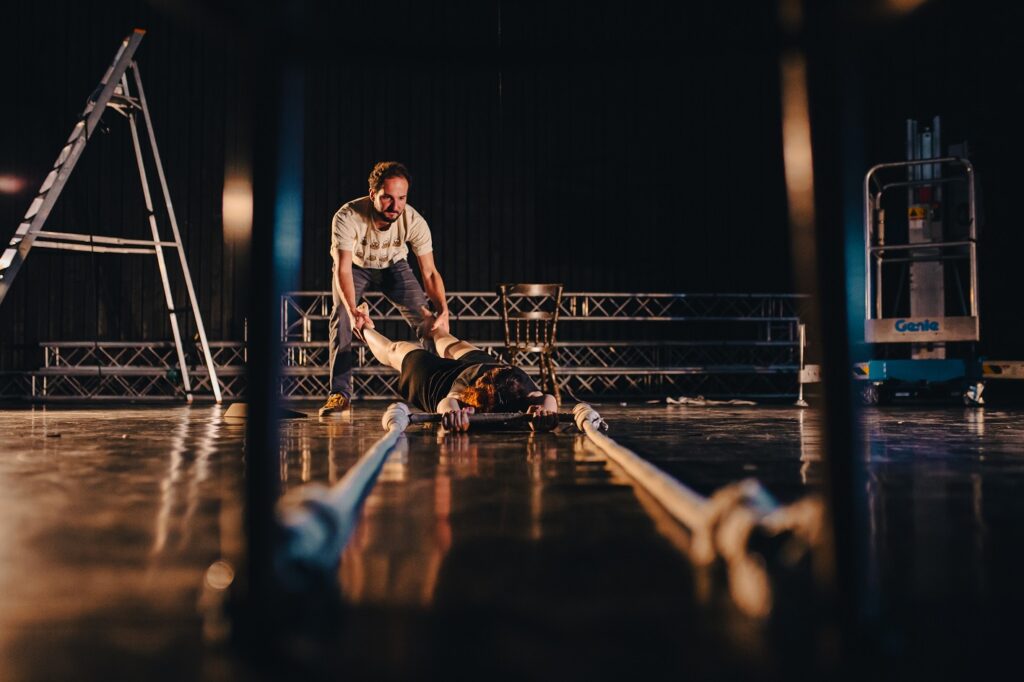

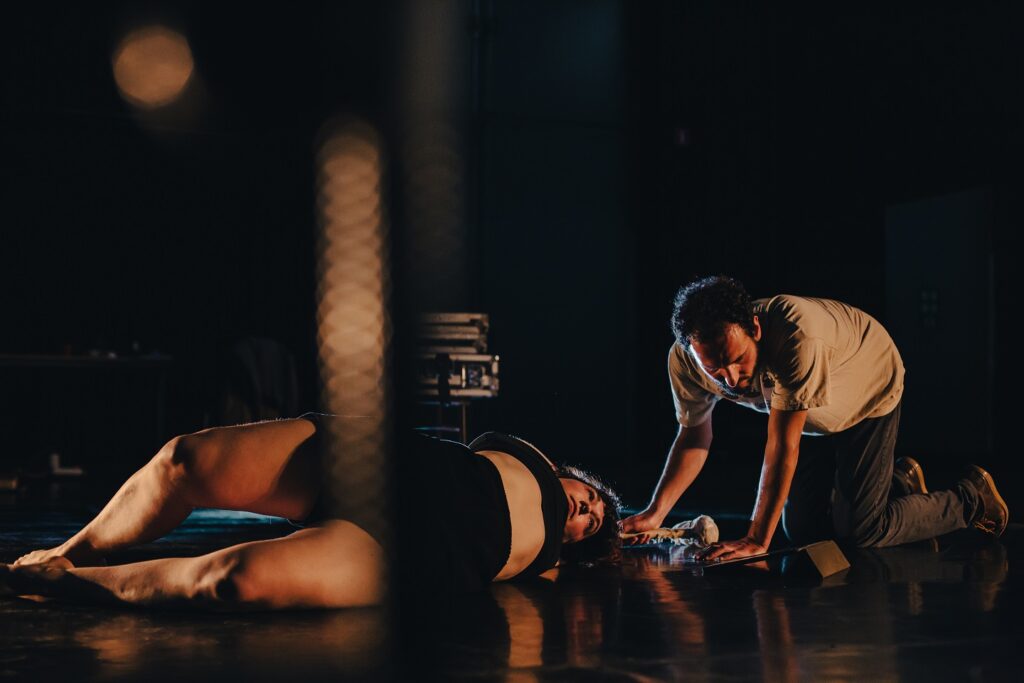
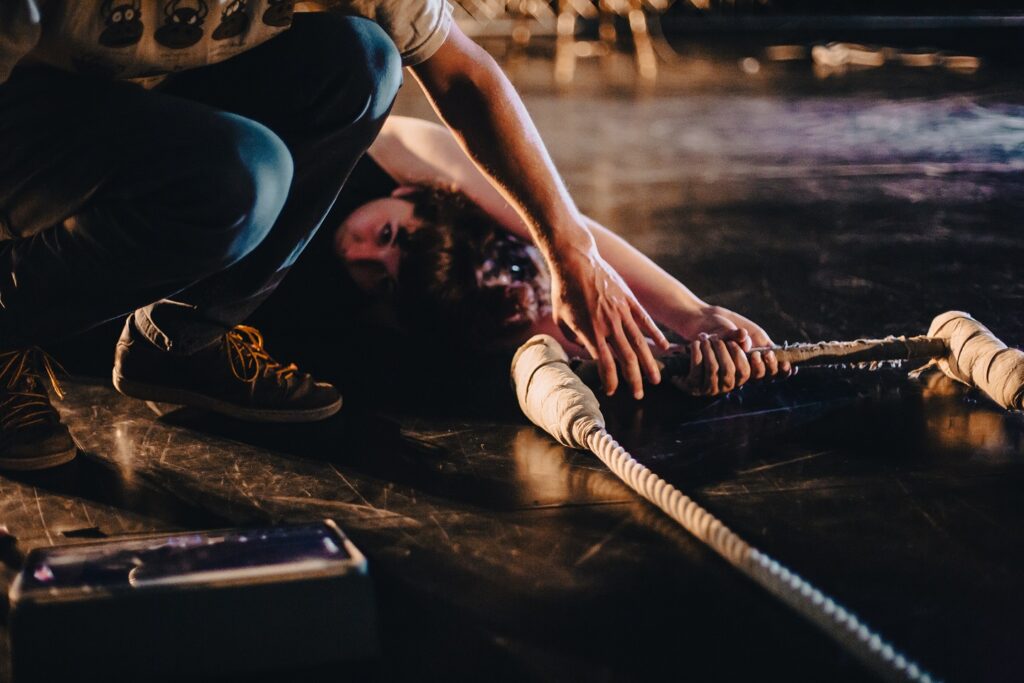
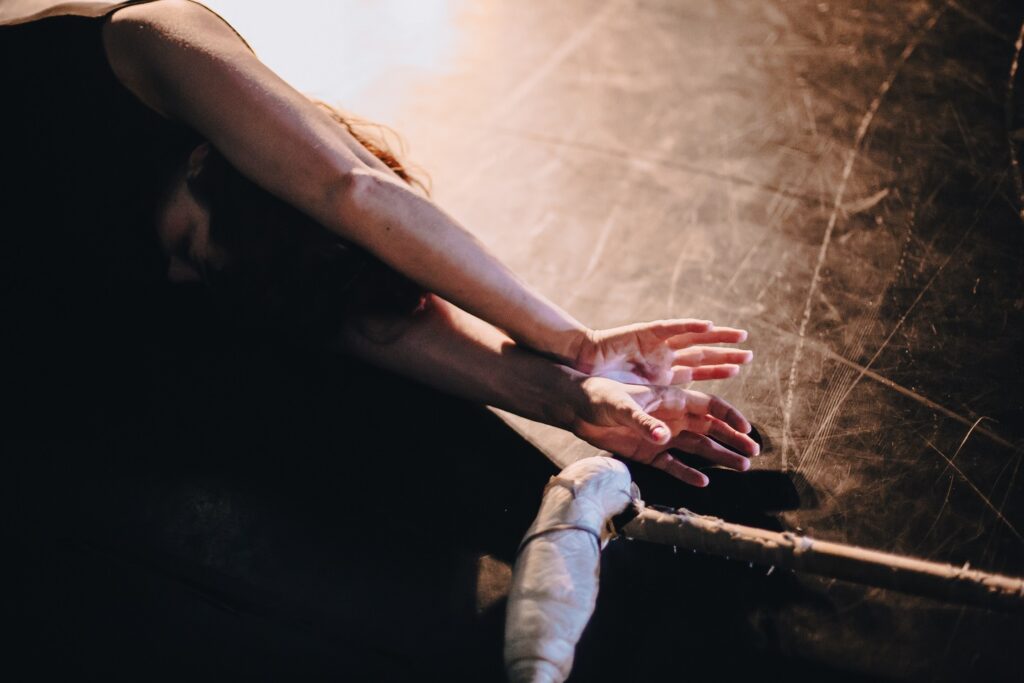
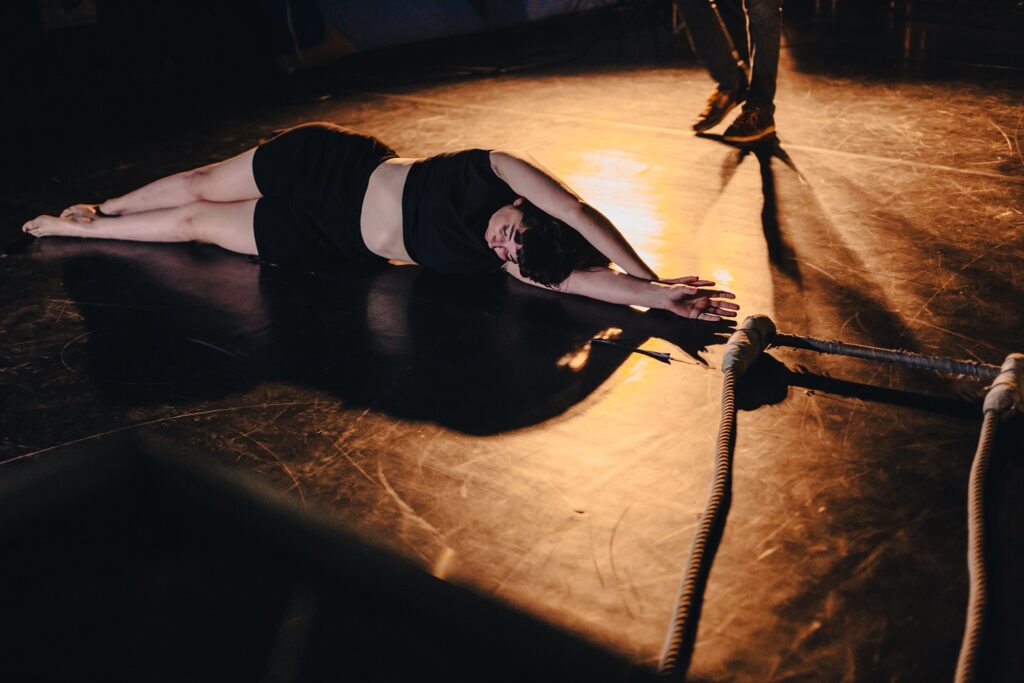
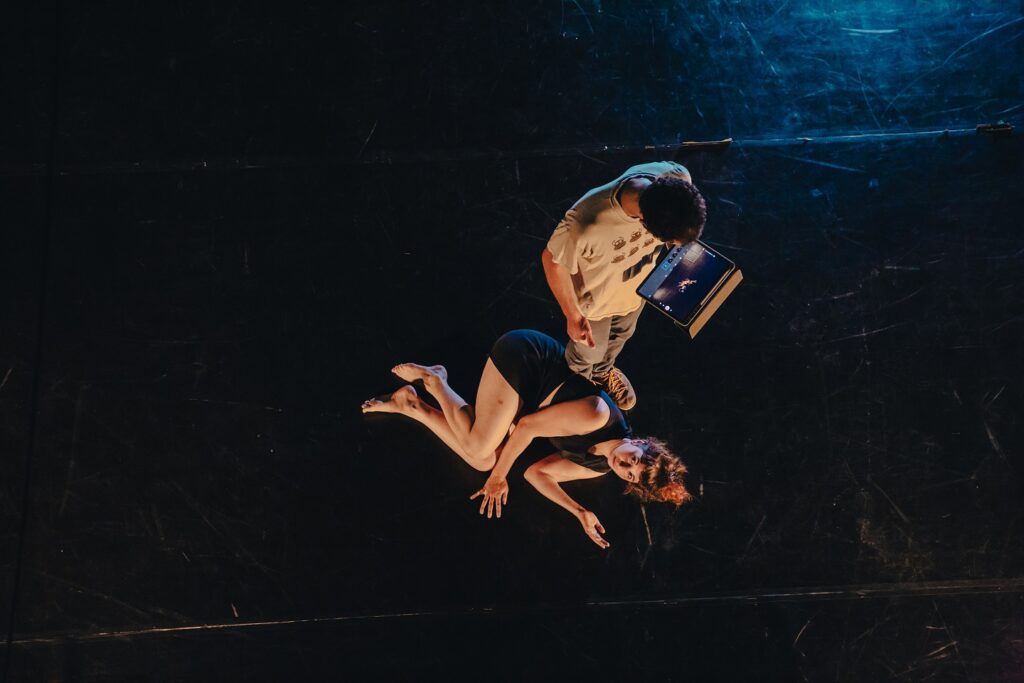

Some numbers
For a 4-minute movie:
>> Natko has taken 2800 pictures
>> Bambou has spent 12 hours lying on the floor
Other paths & research
Video projections & draw on the body
We still wanted, with the technical equipment available in the residency space, to try to make some projections on Bambou suspended from the trapeze. We only tried to draw on the body or the face to create make-up or lines. But we were quickly limited and we didn’t really see the point of this research.
3D character and deep motion
First Natko created a 3D trapezist character because our goal was to make a little catalog called ‘New impossible tricks on a trapeze’. Unfortunately we realized how much time this was going to take for us. This wasn’t really collaboration or teamwork, because it’s Natko who has to spend hours on the computer to animate the character, while Bambou has nothing to do.
We also tried another animation technique: deep motion. It’s an artificial intelligence application that records body movements and transcribes them into a 3D character. Therefore we filmed a few sequences of movement on the trapeze – a few simple tricks. Once again we were limited by technology; this application only detects simple movement of the legs, arms and head, but as soon as we start to move too much or to twist our body, the computer doesn’t understand and that brings a lot of bugs. So we could only film a few simple movements under the trapeze. Natko imports the 3D character into the app – the video of Bambou’s movements – and the app does the job on its own.
After that Natko tried to add a trapeze in the hands of this character. Unfortunately, for an optimal realization without all the bugs it would have taken hours and hours, so we left this research aside in order to spend not too much time on the computer. Here the result with adding the trapeze:
And here without trapeze:
Other possibilities
We think it would be interesting to eliminate the trapeze and to keep only the movements of the trapeze artist. We would also like to replace this 3D human character with another, non-human character like an animal or a plant. Just to keep the essence of the movement of a trapeze artist but applied to another body.
Conclusion
We noticed that we really got better and improved a lot with the hours of recording. The last few episodes of the stop-motion were getting better and better; we had found a way to work together and move forward faster. Certainly, with more time and better equipment (better camera, completely black floor, a third person to help with technical stuff), we could have really improved the end result.
For us this little film is not at all a finished product but rather a work in progress. So we are at the very beginning of a research that could get really interesting. We are happy with the work provided, the result and the interdisciplinary meeting: circus with animated film.
With more time we would have taken more time in the research around 3D characters, in particular with a special suit that captures movements and transcribes them directly into the computer. It was a short but intense experience, which would need to be repeated to go further in the research that we have only touched on.
